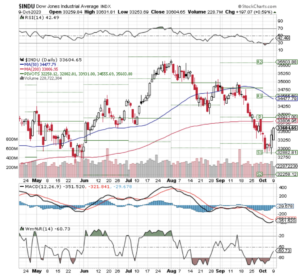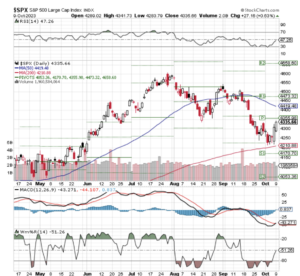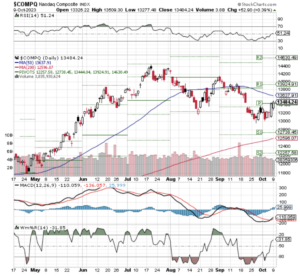HI Market View Commentary 10-09-23
What have we been up to?
– DIS and BIDU protection off for a wonderful profit
– Purchased 100 DIS shares for everyone since we’ve booked
profit a few times on puts.
– Booked profits last week on UAA, BAC and JPM puts
– Today got protection back on BAC and JPM for EARNINGS
Homework:
Look up Thomas Sowell on the FED on YouTube
https://www.briefing.com/the-big-picture
The Big Picture
Last Updated: 06-Oct-23 15:58 ET | Archive
Keeping score with third quarter earnings
When one door closes, another one opens… or so it is said. Well, the door to the third quarter closed
a short time ago, which means the door to the fourth quarter has been opened.
We can't profess to knowing with certainty what the fourth quarter will bring, but we can profess with
certainty that it will bring another earnings reporting period.
It will be the third quarter earnings reporting period, and that period, in our estimation, starts officially
with PepsiCo's (PEP) report before the open on October 10.
There Is a Chance
The earnings performance of the S&P 500 hasn't been good for a while now. In fact, earnings have
declined on a year-over-year basis in each of the last three quarters. If keeping score at home, that
is not a winning streak.
The latter point notwithstanding, the S&P 500 has been on a winning streak for most of that time,
which dates back roughly to the third week of January, thanks to the outperformance of the mega-
cap stocks.
The market-cap weighted S&P 500 has increased approximately 8% over that span, yet it is the
equal-weighted S&P 500 that has been more in tune with the losing streak for S&P 500 earnings.
Over the same period, it has declined approximately 6.0%.
There is a chance, though, for the S&P 500 to break out of its earnings funk. According to FactSet,
the blended third quarter earnings growth rate is -0.37%. That negative sign in front of 0.37 isn't
expected to hold its place. That's because S&P 500 earnings typically exceed the estimated growth
rate by at least two percentage points when the reporting is complete.
If the S&P 500 can hold serve in that respect, there will be a plus sign in front of the growth rate
when the third quarter reporting period is finished, which would also mean that the earnings losing
streak is over.
Top Line Better than Bottom Line
What is known ahead of the reporting period is that the energy sector will be the biggest drag on
third quarter earnings. It is expected to post a 37.9% year-over-year decline in earnings, according
to FactSet, which will subtract 4.64 percentage points from earnings growth.
The only other sectors expected to register a year-year decline in earnings are materials (-23.1%)
and health care (-11.9%). Cumulatively, those declines will subtract 2.60 percentage points from
earnings growth.
What this means is that the remaining eight sectors are all projected to post positive earnings growth
for the third quarter, none more so than communication services (+31.6%), consumer discretionary
(+21.8%), and utilities (+11.5%)
Things look a little better on the top line. The blended growth rate for third quarter revenue is 1.5%.
The energy sector is lopping off 1.86 percentage points from growth, and the materials sector is
subtracting just 0.32 percentage points; otherwise, revenues are expected to increase across the
remainder of the sector spectrum, albeit in a predominately modest fashion.
The Upshot
The fact that earnings are projected to decline while revenue is expected to increase is a reflection
of the expected margin pressure resulting from higher costs. This is an important distinction. When
profit margins are contracting, investors are less willing to pay a premium for every dollar of earnings
that are thought to be at risk of downward revision.
The result, oftentimes, is multiple compression, as stock prices are discounted more quickly than the
earnings estimates. The upshot going into the third quarter reporting period is that analysts are
expecting earnings growth (+8.0%) in the fourth quarter that exceeds revenue growth (+3.9%).
In other words, the door to earnings declines is being shut and the door to earnings growth is being
opened — or so it is thought. One can hope that is the prevailing outcome given that things would be
askew, for lack of a better word, if the outlook for 8.0% earnings growth was supplanted by an
outlook for a decline in fourth quarter earnings.
The upshot is that analysts see a ramp in earnings growth in calendar year 2024. Current estimates
call for 12% growth. That positive outlook is incorporated in rising estimates for the forward 12-
month period, but estimates have been flattening out in recent weeks.
The concern on the market's mind is whether the market will be able to live up to the lofty, forward-
looking estimates given the jump in market rates, China's economic challenges, the resumption of
federal student loan payments, stubbornly high inflation, and the lag effect of higher policy rates in
many developed markets.
What It All Means
The stock market has hit a rough patch in recent weeks. Since the end of July, the market-cap
weighted S&P 500 and equal-weighted S&P 500 have declined 6.1% and 9.6%, respectively. That
pullback has been part of a normal consolidation process after a big run, but it has been catalyzed in
more recent weeks by the sharp jump in long-term rates.
With the start of the third quarter earnings reporting period approaching, the market-cap weighted
S&P 500 trades at 17.8x forward 12-month earnings, which is slightly ahead of its 10-yr average
(17.5). The equal-weighted S&P 500 trades at 14.1x forward 12-month earnings, which is nearly a
20% discount to its 10-year average (17.6).
In brief, there has been multiple compression driven by rising interest rates that have stirred
valuation angst and have posed a competitive headwind for stocks. That valuation angst is tied up in
worries about future earnings growth, but as the chart above shows, those worries have not
registered in analysts' aggregate earnings estimates.
That understanding is why the third quarter earnings reporting period holds added significance for
any potential rebound effort. The reason being is that third quarter reports, in many cases, will
contain guidance for the fourth quarter and maybe even for calendar 2024.
It is those projections that will matter most, as they are the door to the market's assessment of
whether current estimates will be revised higher or lower. If keeping score at home, higher is better
than lower.
–Patrick J. O'Hare, Briefing.com
https://www.briefing.com/the-big-picture
There are certainly some "issues" out there to support the view that things should be
slowing down:
Student loan payments are set to resume October 1.
Oil prices are stubbornly high; and drivers continue to be saddled with high gas prices.
The U.S. government seemingly looks headed for a shutdown.
The disinflation momentum has slowed.
China's post-Covid economic recovery efforts have been sluggish and are being threatened
further by cracks in its property market.
The UAW is about to enter its third strike week against the Big Three automakers.
The Fed, ECB, Bank of England, and many other central banks all seem inclined to keep
rates higher for longer.
The lag effect of prior rate hikes has yet to show up in a meaningful way in a broad sense.
– War in Israel and Palestine with Hamas inciting heavy reactions
from Israel by kidnapping, killing etc. etc.
Earnings dates:
AAPL – 10/24 Est.
BA – 10/25 Est.
BAC – 10/17 BMO
BIDU – 11/21 Est.
CVS –
DIS – 11/8 BMO
F – 10/26 AMC
GE –
GOOGL – 10/24 AMC
JPM – 10/13 BMO
KO –
LMT –
LUV –
META- 10/25 AMC
SQ –
UAA – 11/2 BMO
V – 10/24 AMC
VZ –
MU- 12/21
Where will our markets end this week?
Higher
DJIA – Bearish
SPX –Bearish
COMP – Bearish
Where Will the SPX end Oct. 2023?
10-02-2023 +1.0%
10-09-2023 +1.0%
Earnings:
Mon:
Tues:
Wed:
Thur: DAL, DPZ
Fri: BLK, JPM
Econ Reports:
Mon:
Tue Inventories
Wed: PPI, FOMC minutes
Thur: CPI, Initial Claims, EIA gas and oil inventories
Fri: Import/Export Prices
How am I looking to trade?
Following market direction and getting protection on as needed
at higher strike prices for Earnings Reports.
www.myhurleyinvestment.com = Blogsite
info@hurleyinvestments.com = Email
Questions???
https://www.dailysignal.com/2023/09/28/time-to-end-the-fed-
and-its-mismanagement-of-our-economy/
COMMENTARY BY
EJ Antoni@RealEJAntoni
EJ Antoni is a public finance economist and research fellow in The Heritage Foundation's Grover
M. Hermann Center for the Federal Budget.
Peter St. Onge@profstonge
Peter St Onge is a research fellow in economics in the Roe Institute for Economic Policy Studies
at The Heritage Foundation. He holds a doctorate in economics from George Mason University.
Every major economic downturn of the last 110 years bears the mark of the Federal
Reserve. In fact, as long as the Fed has been around, it has swung the economy
between inflation and recession. Yet Americans, surprisingly, have tolerated it.
But we shouldn’t expect that to go on forever. We had three central banks
before the Fed, and confined each to the ash heap of history. The problems inherent to
central banking are cause to scrap the Fed as well.
Central banking dates to 1694, when the Bank of England was founded for the purpose
of creating the hidden tax of inflation to provide cheap money to government—above all,
for Britain’s many foreign wars. In exchange, the central bankers were paid well with
interest.
Like any government-favored bank, the Bank of England lent money it didn’t have,
lending far more than the silver in its vaults. The British government endorsed this fraud
because the king and Parliament wanted the money.
But the fraud went further still: The Bank of England was allowed to use its new
government bond holdings to back private loans, which meant creating even more
money with no silver behind it to lend to private banks. This, too, earned interest, even
though the money was created out of nothing.
The explosion of money caused a tissue fire in the British economy—a short period of
fast growth followed by rampant inflation and an economic collapse. The boom-bust
cycle was born, what we now call the “business cycle.”
When the Bank of England didn’t have enough silver to exchange for all the money it
created, the British government pulled the 18th-century equivalent of a bailout by
suspending specie redemption, allowing the Bank of England to stop repaying in the
silver it had promised.
Central banking was imported to the New World before the Constitution was even
written. The Bank of North America, our first central bank, copied the Bank of
England and created hyperinflation under the Articles of Confederation. At that point,
the Founding Fathers scrapped both the Articles of Confederation and the bank.
Thinking that the bank needed a replacement, Congress created the First Bank of the
United States in 1791 to consolidate the various currencies and debts from the states
and to provide short-term loans to the government.
The First Bank was forbidden from buying government bonds to avoid its predecessor’s
hyperinflation. But when the government needed more revenue, Congress decided to
sell its shares in the bank, and the charter wasn’t renewed. The central bank was dead,
and the U.S. economy boomed until the War of 1812.
To finance that war, the government borrowed heavily from regional banks, which
created money out of nothing for the government. That meant that much more paper
money was in circulation than gold and silver in bank vaults. When people tried to
redeem their paper for specie, the banks didn’t have enough, and many failed.
To bail out the banks, Congress created another central bank in 1816, the Second Bank
of the United States.
The Second Bank curtailed excessive lending by regional banks, but only after first
encouraging it. The result was a debt-fueled boom followed by a bust in 1819 that
sparked the nation’s first depression.
Many in Congress were tolerant of the violent economic spasms caused by the central
bank because it provided money for them to spend without overtly raising taxes. But the
people were not fooled and would not tolerate it. They elected Andrew Jackson to do
battle with the beast, and he ensured the bank’s charter wasn’t renewed in 1836.
That ushered in some of America’s greatest decades of economic growth.
The Golden Age came to an end in 1907 when mismanagement by major banks
touched off a bank crisis that required a herculean rescue effort by J.P. Morgan and Co.
In response, J. Pierpont Morgan wanted the government to sanction a private “bank for
bankers” to respond to such crises.
The progressives in Congress refused because, as Sen. Nelson Aldrich, R-R.I., said,
“We may not always have Pierpont Morgan with us to meet a banking crisis.” And so,
shortly after Morgan’s death in 1913, the politicians created a fully government-run
institution to bail out government and bad banks alike: the Federal Reserve.
The boom-bust cycle was on steroids from that moment on.
The Fed ominously began with an inflationary boom to pay for World War I, ending in
the depression of 1920. It created another inflationary boom to keep Britain afloat in the
late 1920s, which set off the Great Depression. Every five to 10 years for the last
century, the Fed has created, then popped, bubble after bubble, each time taking down
swatches of the American economy.
Just in the past three decades, the Fed’s low interest rates caused the dot-com bubble
in the 1990s, then the housing bubble and a global financial crisis in 2008. Today,
there’s an “everything bubble” from the Fed’s panic-printing to bribe voters into
lockdowns, yielding the combined risks of 1970’s stagflation and a 2008-style bank
collapse.
Since its founding, the Fed has stolen 98% of the value of a dollar. It has used those
profits to repetitively launch boom-bust cycles and to transfer trillions to the federal
government, special interests, and wealthy borrowers.
Jackson did not tolerate such thieving rampages from his central bank. And we need not either.




HI Financial Services Mid-Week 06-24-2014